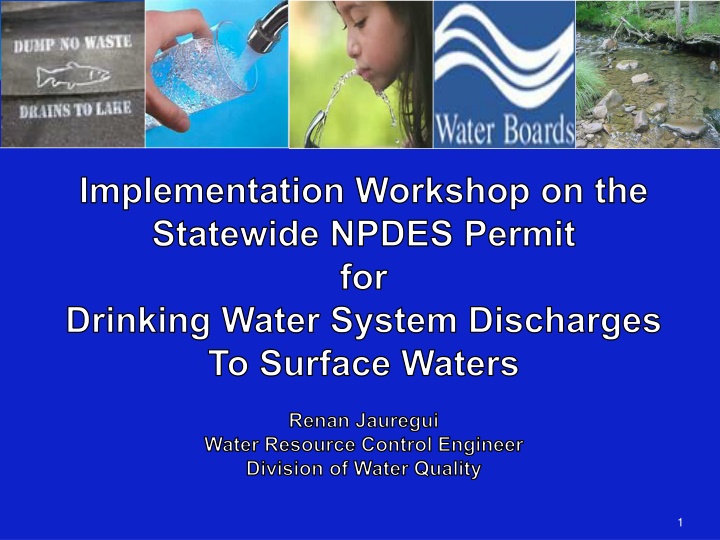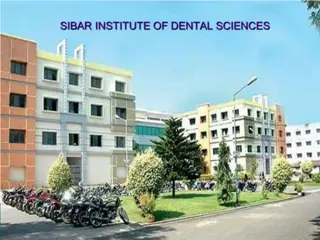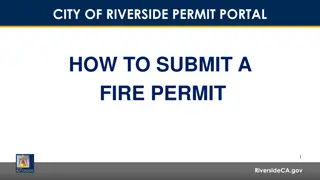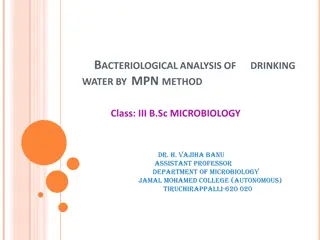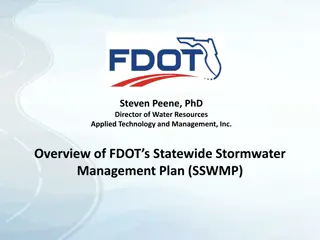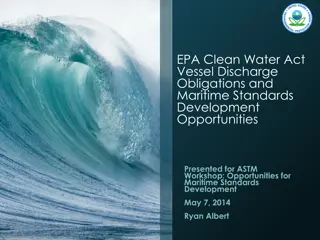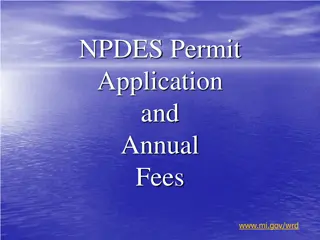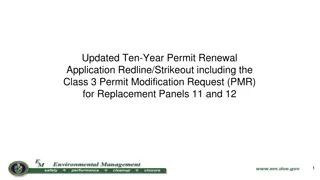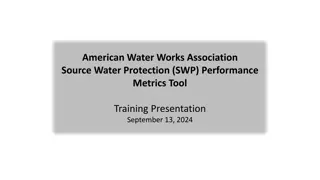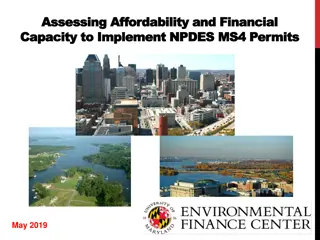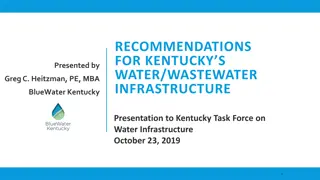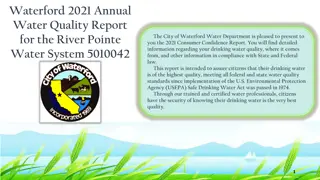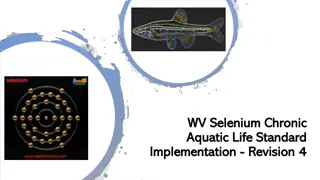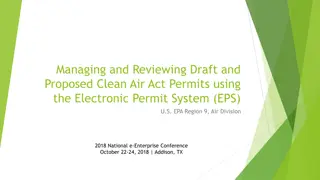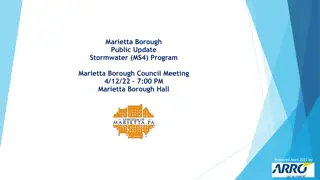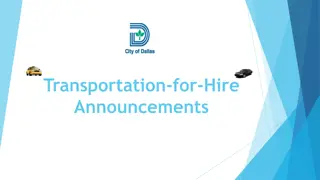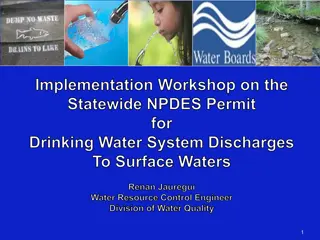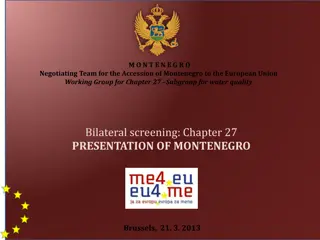Statewide NPDES Permit for Drinking Water Systems Workshop
Implementation workshop on the Statewide NPDES Permit for Drinking Water System Discharges. Details enrollment requirements for water purveyors, authorized discharges types, and effluent requirements. Includes BMPs, effluent limitations, and discharge compliance criteria for various water systems. The workshop outlines regulations for CDWS, wholesalers, MS4 permittees, and non-community water systems. It emphasizes environmental protection and water quality management.
Download Presentation

Please find below an Image/Link to download the presentation.
The content on the website is provided AS IS for your information and personal use only. It may not be sold, licensed, or shared on other websites without obtaining consent from the author.If you encounter any issues during the download, it is possible that the publisher has removed the file from their server.
You are allowed to download the files provided on this website for personal or commercial use, subject to the condition that they are used lawfully. All files are the property of their respective owners.
The content on the website is provided AS IS for your information and personal use only. It may not be sold, licensed, or shared on other websites without obtaining consent from the author.
E N D
Presentation Transcript
prgrsvimghttp://ts1.mm.bing.net/th?id=H.4593000514128230w=103h=103c=8pid=3.1qlt=90prgrsvimghttp://ts1.mm.bing.net/th?id=H.4593000514128230w=103h=103c=8pid=3.1qlt=90 http://ts1.mm.bing.net/th?id=H.5020852248644160pid=1.7w=184h=182c=7rs=1 http://ts2.mm.bing.net/th?id=H.4570400405193537pid=1.7w=224h=164c=7rs=1 Implementation Workshop on the Statewide NPDES Permit for Drinking Water System Discharges To Surface Waters Renan Jauregui Water Resource Control Engineer Division of Water Quality 1
DWS NPDES Permit Enrollment Who is required to enroll Water Purveyors that are Community Drinking Water Systems (CDWS) with 1000 connections or more Wholesalers regardless of the number of connections Who would not be required to enroll Community Drinking Water System with less than 1000 connections. Transient, non-transient and non-community drinking water systems. CDWS that are also MS4 Permittees. CDWS that have an established MS4 local agreement and approved by their local Regional Board. CDWS whose discharges do not enter a water of the U.S. CDWS whose system-specific or water-body specific discharges require an individual Regional Board NPDES permit due to a TMDL or because the discharge falls outside the scope of the statewide permit. 2
Permit Authorized Discharges Type of Discharges Authorized (sample list) Planned Groundwater supply well flushing or pump to waste Groundwater well development, rehabilitation and testing Transmission system installation Distribution system storage tank or reservoir releases Distribution system dewatering, flushing, pressure testing Fire hydrant flushing, meter testing, automated water quality analyzers operations. Water Treatment plant operations (excluding backwash filter that discharges to a water of the U.S.) Discharges due to activities undertaken to comply with mandates of the Federal Drinking Water Act and Ca Health and Safety Code Emergency and Unplanned Drinking water system failures, including repairs on transmission or distributions system failures Trench dewatering due to a system failure or emergency failure Operation errors and discharges due to catastrophic events. 3
DWS NPDES Permit Effluent Requirements Effluent Requirements/Limitations for discharges that enter a water of the U.S. Establish Best Management Practices (BMPs) to: Prevent aquatic toxicity of chlorine by dechlorination Prevent erosion and hydromodification by erosion control and prevention measures Minimize Sediment discharge and turbidity impacts through sediment, turbidity, and erosion controls Prevent water quality impacts from groundwater supply well operations such as well development and rehabilitation by complying with a turbidity action level of 100 NTU or less in the discharge, and change or enhance BMPs when turbidity levels are greater than 100 NTU Applicable to all planned discharges that enter a water of the U.S. Comply with the following effluent limitations: A total chlorine residual maximum of 0.019 mg/L (inland waters, enclosed bays and estuaries) or 0.008 mg/L (ocean) with compliance assessed by a field meter monitoring result of <0.1 mg/L (non-detect) for total chlorine Only applicable to superchlorinated discharges, direct discharges, or discharges within 300 ft from a water of the U.S. A turbidity limit of 225 NTU for Ocean discharges only. 4
Compliance Determination for Chlorine Limits Total Chlorine Compliance Result Would be Reported Compliance Determination Level In Compliance <0.10 <0.1 <0.1 Yes 0.10 0.1 <0.1 No 0.14 0.1 <0.1 No 0.06 <0.1 <0.1 Yes <0.06 <0.1 <0.1 Yes 0.05 <0.1 <0.1 Yes 0.04 <0.1 <0.1 Yes 5
DWS NPDES Permit Effluent Requirements Types of BMPs are left to the discretion of the CDWS (include but not limited to those established by AWWA) Emphasis on BMPs to be the primary control of toxicity, solids, trash, erosion, scour and hydromodification BMPs listed in Attachment C of the permit are examples 6
Permit Monitoring Requirements Monitoring requirements. Event effluent monitoring: (per event) Superchlorinated discharges (volume, chlorine, pH, and visual turbidity) High volume discharges (1ac-ft or larger) (volume, chlorine, visual turbidity) Well development /rehabilitation (volume, chlorine, and metered turbidity) If discharge <20 min then one sample during first 10 min If discharge between 20 to 60 min then one sample first 10 min and second sample during last 10 min. If discharge >60 min then one sample first 10 min, second within 50 min and last one within last 10 min of discharge or close to end of discharge as feasible. Representative effluent monitoring: (annual- chlorine, volume, visual turbidity) All other types of discharges that represent same general water source, same water treatment, and same type of implemented BMPs. Same frequency as event monitoring dependent on duration of discharge. 7
Permit Monitoring Requirements, continued Receiving water monitoring: Visual monitoring (erosion, discoloration, suspended matter, aquatic life impact, visible films, sheens, potential nuisance conditions) Only applicable when direct planned discharges do not comply with permit requirements. (not applicable for emergency discharges). 8
Emphasis on Beneficial Use or Reuse No monitoring is required if water is put to a beneficial reuse such as: Using the water that would otherwise be discharged for irrigation or other uses (e.g dust control) Putting the water that would otherwise be discharged to land disposal for ground water infiltration and recharge 9
Notification and Reporting Requirements Notification of emergency or noncompliant discharges (upon becoming aware of impacts to beneficial uses) Notify Regional Board within 24 hrs and in writing within 5 days Notify Stormwater System Operator with 24 hrs. Pre-Notification of large planned discharges >1acre-ft: Notify Regional Board and Stormwater System Operator 3 days prior to initiating discharge or retroactively within 24 hrs after the Discharger is informed to initiate a large volume discharge Reporting to State Water Board by March 1 of every year: All non-compliant discharge monitoring information A record of the number of direct discharges that are >50,000 gal for the year An estimate of the total volume discharged to waters of the U.S. during the year. An estimate of the total volume of discharged water that was put to a beneficial reuse instead of discharging to a water of the U.S. 10
NPDES Permit Application Checklist Notice of Intent form completed and signed for each CDWS Application fee payable to the SWRCB included Site information provided Option of providing general location of the facilities or the boundaries of the service area(s) Need only to show the named receiving waters and the major named downstream waters For discharges within 300 feet of a water body, the Discharger is only expected to submit the representative distance of 300 feet on both sides of the named water bodies or indicate the entire service area is within 300 feet from a water body. TMDL Waterbody information completed and submitted 2 samples laboratory analysis for parameters listed in Table F-2 for each applicable TMDL waterbody representative of the discharges The estimated minimum and maximum discharge volume per discharge event and estimated average annual discharge volume going to the TMDL waterbody. Description of TMDL specific BMPs if any. 11
Application Information Water Watch Website https://sdwis.waterboards.ca.gov/PDWW/ 12
Notice of Intent (NOI) Example Sections 1, 2 13
NOI Example Sections 3, 4 14
NOI Example Section 5 15
NOI Example Section 6 16
NOI Example Section 7 http://www.waterboards.ca.gov/water_issues/programs/tmdl/integrated2012.shtml 17
NOI Example Section 8 and 9 18
NOI Example Certification/Signature 19
Mapping Requirements DWS Geographic Tool http://www.ehib.org/page.jsp?page_key=61 20
Permit TMDL Clarifications Permit applies to TMDLs with established WLAs in Los Angeles (Region Board 4) and San Diego Regions (Regional Board 9) only. All applicable TMDL waterbodies have been listed in the Permit (Table F-2). The requirements in this Permit do not apply to non-listed TMDLs Monitoring required will be evaluated with dry and wet weather WLAs per the applicable specified TMDLs in the fact sheet of the Permit. 21
Permit TMDL Application Requirements Minimum of 2 samples representative of the system s discharge. Historical data is appropriate if it represents the discharges. Examples of appropriate data TMDL for Pb and Cu From groundwater supply wells or blended distribution system Data from your consumer confidence reports can be submitted Samples from tap for Cu and Pb rule compliance may not be appropriate (concentrations may be higher and not representative of actual discharge). TMDL for Nitrate, ammonia, total coliform (e-coli) From groundwater supply wells or blended distribution system Data from your consumer confidence reports can be submitted If have data for total Nitrogen, this can represent Nitrate or ammonia data. If show non-detect for total coliform, this can be indicative of non-detect for E-coli for the distribution system. To properly assess discharge with TMDLs need to submit minimum and maximum estimated volume per discharge event and average discharge volume per year. Also include any TMDL-specific BMPs established and/or to be implemented 22
Permit TMDL Assessment Review data submitted. Compare it to established WLAs If it does not exceed the WLA, then proceed with NOA. If it does exceed the WLA (either dry or wet weather) then State Board staff will review the estimated volume discharge data and discuss with corresponding Regional Board if additional BMPs may be necessary. 23
Permit Supplemental TMDL related Requirements Table F-2 Clarification Should include and Immediate Tributaries 24
Notice of Non-Applicability Discharges from the drinking water system solely enter a water of the U.S. via a municipal separate storm sewer system (MS4) and there is a local agreement established with the MS4 Permittee and approved by the local Regional Water Board. The drinking water system is owned or operated by the MS4 Permittee and all discharges enter a water of the U.S. via the permitted MS4 system. The drinking water system is regulated under an existing individual Regional Water Board Permit due to threat to water quality above the low-threat scope of the statewide permit, or due to the need to address TMDL-specific requirements. The drinking water system does not discharge to a water of the U.S. or a conveyance that drains to a water of the U.S. 25
prgrsvimghttp://ts1.mm.bing.net/th?id=H.4593000514128230w=103h=103c=8pid=3.1qlt=90prgrsvimghttp://ts1.mm.bing.net/th?id=H.4593000514128230w=103h=103c=8pid=3.1qlt=90 http://ts1.mm.bing.net/th?id=H.5020852248644160pid=1.7w=184h=182c=7rs=1 http://ts2.mm.bing.net/th?id=H.4570400405193537pid=1.7w=224h=164c=7rs=1 Questions? Questions? Renan.jauregui@waterboards.ca.gov 26
